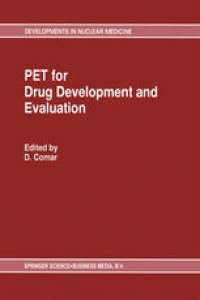
Ebook: PET for Drug Development and Evaluation
- Tags: Imaging / Radiology, Nuclear Medicine, Pharmacology/Toxicology
- Series: Developments in Nuclear Medicine 26
- Year: 1995
- Publisher: Springer Netherlands
- Edition: 1
- Language: English
- pdf
Can drug development and evaluation be improved by the use of positron emission tomography (PET)? PET is now well established and many PET centres participate in networks that warrant the quality of their research. PET allows one to follow the effect of a drug on a variety of patients' metabolic parameters. In addition, PET may be used to follow the fate in vivo of a compound, allowing visualisation of its binding to specific receptors and a direct study of the mechanism of drug action in normal and pathological situations.
The book shows the fields in which PET offers new and unique information for the development of drugs (conception, toxicity, pharmacokinetics and metabolism, clinical research, and relations between clinical and biological effects) and evaluates fields in which PET may shorten the development time of drugs.
Audience: Professionals in the pharmaceutical industry in all areas of drug discovery and pharmacology, pre-clinical testing, pharmacokinetics and metabolism, clinical evaluation, registration and regulatory affairs. Government health authority representatives who assess data and documentation on new drug development and radiopharmaceuticals. Academic experts concerned with any of these areas.
Can drug development and evaluation be improved by the use of positron emission tomography (PET)? PET is now well established and many PET centres participate in networks that warrant the quality of their research. PET allows one to follow the effect of a drug on a variety of patients' metabolic parameters. In addition, PET may be used to follow the fate in vivo of a compound, allowing visualisation of its binding to specific receptors and a direct study of the mechanism of drug action in normal and pathological situations.
The book shows the fields in which PET offers new and unique information for the development of drugs (conception, toxicity, pharmacokinetics and metabolism, clinical research, and relations between clinical and biological effects) and evaluates fields in which PET may shorten the development time of drugs.
Audience: Professionals in the pharmaceutical industry in all areas of drug discovery and pharmacology, pre-clinical testing, pharmacokinetics and metabolism, clinical evaluation, registration and regulatory affairs. Government health authority representatives who assess data and documentation on new drug development and radiopharmaceuticals. Academic experts concerned with any of these areas.